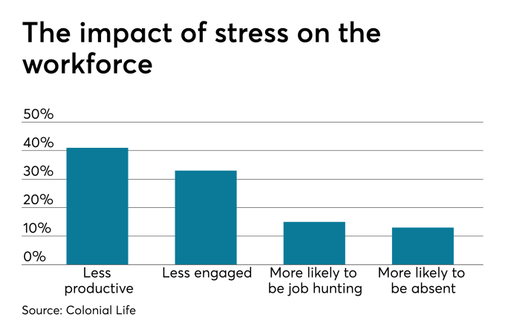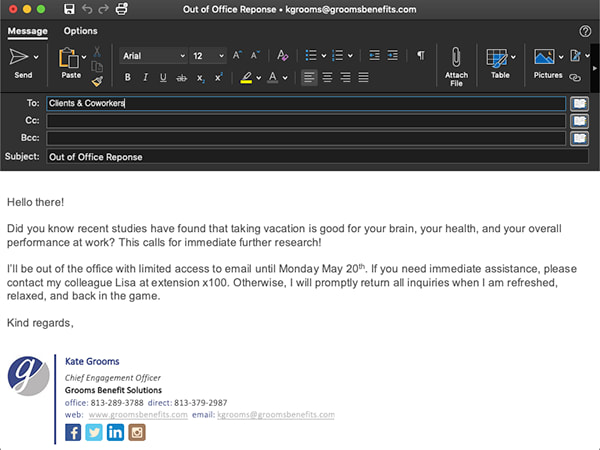|
Business owners, HR leaders, and team managers – listen up. Your employees are totally stressed out. Stress is a fast-growing, no chance of stopping anytime soon problem in our country that affects not only the health and well-being of your employees, but also hinders the productivity of your organization. And it is unavoidable. The study that shows us everything More than 20% of workers spend more than five hours on the clock each week thinking about their stressors and worries, according to a new survey from Colonial Life. An additional 50% of workers said they lose between one and five hours of work due to stress every week. Not surprisingly, topping the list of employee stressors are work (29%) and finances (24%). Additional causes of stress include personal/spousal healthcare, family obligations, and caring for elderly family members. And it isn’t news to your employees that increased stress is impacting their work performance. In fact, 41% of survey respondents said they know their productivity levels have dropped due to stress, and 33% of them said stress made them feel less engaged at work. Noticing signs of stress As a business owner or HR leader, you may not have time for a daily feel-good sit down with each employee to find out how every situation in their life is currently going. But those you’ve put in team leadership positions, and who have daily interactions with your workforce, can watch for symptoms and signs that it’s time to take action and help. Symptoms to watch out for might include:
Chronic stress can also cause a variety of health symptoms that might affect the overall well-being of your employees. Stress can contribute to heart disease, high blood pressure, diabetes, obesity, and various gastrointestinal problems. Employees that battle these conditions tend to need extra health care, which directly contributes to the amount of money employers are spending on health benefits. You could be paying as much as 50% more on the health care costs of your stressed employees. In 2018 alone, US employers spent almost $200 billion dollars on health care due specifically to stress-related chronic conditions. Tools for coping with stress The way that people deal with stress is different from person to person. There is no one-sized solution to help. But there are small changes your organization can make to help employees manage their stress, without breaking the bank or prying too much in to people’s personal lives. 1. Have an EAP. Talk about EAP. An employer-sponsored employee assistance plan (EAP) is a confidential work-based program designed to identify and assist employees and their families in resolving personal problems that may be adversely affecting their performance at work, such as marital, financial or emotional problems, family issues, or substance or alcohol abuse. EAP’s are an invaluable resource to the 77% of companies that provide them, but they are being drastically under used. Employees will simply not engage with their EAP unless they understand what the program really offers, so it’s your job as an employer to promote the services and educate on the benefits of using them. In addition to providing information about EAP services during employee orientation and open enrollment, employers should frequently push out information as part of their employee well-being strategy. (Don’t have one of those? Get one here.) 2. Flexible schedules are a game-changer. According to a study by the National Work/ Life Measurement Project, 87% of employees reported that flexible work schedules have had a very positive impact on their stress levels and productivity, while significantly improving their quality of work. Not only are employees given more control over how they put their time in, they are also working in an environment of trust. With happier employees and a more trusting environment, stress levels decrease and productivity increases. Understandably not every employer can take advantage of flexible work time, but every little bit you can do counts. Even a gesture like offering one work-from-home day a month (or a few extra PTO days per year for those who absolutely have to be onsite) can make a big difference. 3. Make work-life balance a priority. Employees need to balance work with the rest of the activities they want to enjoy in life. (FYI, work balance is especially important to your millennial employees who are used to cramming their days with diverse activities and hours of electronic communication.) You are not responsible for providing perfect work-life balance for your employees, but you can assist them in seeking and maintaining their own balance. Flexible schedules (see above!) work for this, as well as making sure your employees are taking their hard-earned PTO. And don’t get bogged down in “sick days vs vacation days”. Treat employees like adults and allow them to choose when and why they take their paid time off. And encourage them to take it, even if it means implementing a “no roll over” policy. With employees electronically connected to the workplace 24 hours a day, 7 days a week (in the office or out) work-life balance becomes even more of a challenge. Make sure your company sets the expectation that when an employee is out for PTO, it is okay to set up an email response that says they are without access to email, and to provide contact information for someone else who can assist. Honor your employee’s PTO by not contacting them unless it is truly an emergency. 4. Encourage mindfulness and movement. Encouraging employees to use skills such as mindfulness and movement can help them learn to cope in difficult and stressful situations. Practicing mindfulness in the workplace (like meditation or breathing exercises) can result in positive behavior changes that will enhance and prolong mental wellbeing. Recent studies have measured the detrimental effects of sitting at a desk for 8 hours a day, so encourage employees to take breaks, take walks, or to just disengage from whatever project they are working on for a few minutes. After a short break, employees will see things more clearly, and feel refreshed and re-energized to tackle the rest of the day. Many employers are also implementing “walking meetings” which are relaxing, refreshing, and also productive. 5. Improve communication. When it comes to stress and well-being, there is no such thing as over-communication. And all of the great strategies and ideas discussed here will make huge strides in fighting off workplace stress… but not if employees are unaware such benefits and programs exist. It’s important to communicate regularly with employees in ways that are meaningful to them. Whether it’s passive (like providing a monthly email with tips on how to manage stress) or disruptive (like setting up one-on-one feedback meetings between managers and teams to discuss stress-related issues) it will make your employees feel heard. And speaking of being heard, remember communication works both ways. There is no better way to find out how much stress your staff is dealing with than going directly to the source. And if you’re looking for ways to help stressed out employees and don’t know where to start, JUST ASK THEM. If you notice people are struggling to find balance, find out what changes they think would improve their situation. This way you can accurately gauge how your people are feeling and make the adjustments you need to ensure they have the right balance. People will tell you exactly what they need, you just have to make sure to listen, acknowledge, and thank them for their insight. Author: Kate Grooms, Chief Engagement Officer, Grooms Benefit Solutions With a 15-year resume surrounding internal communications for Fortune 500 clients, and an inspiring love of all things well-being, Kate knows how to keep things real around here. If you’re looking for a better way to communicate and connect with your employees, you can reach out to her at [email protected].
0 Comments
Leave a Reply. |
Our WritersWe ask that all employees at Grooms Benefit Solutions contribute ideas to our Insights blog. Everyone here has a voice, and we love that. Topics
All
Inbox Insights
By subscribing, you agree to hear from us once in a while. Unsubscribe at any time. See our full privacy policy here.
Archives
August 2023
|
|
OUR SERVICES
|
OUR CULTURE
|
© 2024 GROOMS BENEFITS - ALL RIGHTS RESERVED
|




